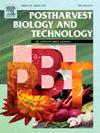SlATG5 对一氧化氮介导的采后番茄果实抗干擾菌过程中 ROS 的积累至关重要
IF 6.4
1区 农林科学
Q1 AGRONOMY
引用次数: 0
摘要
自噬是一种高度保守的细胞内降解过程,它能有效消除各种压力(包括病原体)造成的受损细胞。虽然一氧化氮(NO)作为增强抗病能力的初始信号分子已经为人所知,但自噬与一氧化氮之间的潜在分子机制仍不清楚。在这项研究中,敲除 SlATG5 会加剧疾病症状并促进活性氧(ROS)的积累。此外,NO会增加SlATG5的表达,而缺失SlATG5也会降低NO的含量和NOS酶的活性。更重要的是,敲除 SlATG5 会降低 NO 在抗病中的积极作用,与 SNP+WT 相比,SNP+slatg5 的 CHI 和 PPO 酶活性更低,ROS 水平更高。此外,SlATG5 还能诱导乙烯和叶绿素信号转导。缺失 SlATG5 后,乙烯受体 ETR3 和 ETR5 的表达明显上调,而与辅素相关的基因 SlIAA1、SlIAA12 和 SlIAA17 的表达明显受到抑制。因此,我们的数据表明,SlATG5 参与了 NO 诱导的番茄果实对 B.cinerea 的抗性,并诱导了乙烯和辅素信号的响应。本文章由计算机程序翻译,如有差异,请以英文原文为准。
SlATG5 is crucial for the accumulation of ROS in postharvest tomato fruit resistance to B.cinerea mediated by nitric oxide
Autophagy is a highly conserved intracellular degradation process that effectively eliminates damaged cells caused by various stresses, including pathogens. While nitric oxide (NO) as the initial signaling molecule in enhancing disease resistance is known, the potential molecular mechanism between autophagy and NO remains elusive. In this study, knockout of SlATG5 intensified the symptoms of disease and promoted the accumulation of reactive oxygen species (ROS). In addition, NO increased the expression of SlATG5, and the absence of SlATG5 also reduced the content of NO and the activity of NOS enzyme. More importantly, knockout of SlATG5 reduced the positive role of NO in disease resistance, which is accompanied with lower enzyme activity of CHI and PPO, and higher level of ROS in SNP+slatg5 compared to SNP+WT. In addition, SlATG5 induced the response of ethylene and auxin signaling. After the deletion of SlATG5, the expressions of ethylene receptors ETR3 and ETR5 were significantly up-regulated, and the auxin-related genes SlIAA1, SlIAA12, and SlIAA17 were significantly inhibited. Thus, our data demonstrate that SlATG5 participates in NO-induced tomato fruit resistance against B.cinerea and induces the response of ethylene and auxin signaling.
求助全文
通过发布文献求助,成功后即可免费获取论文全文。
去求助
来源期刊

Postharvest Biology and Technology
农林科学-农艺学
CiteScore
12.00
自引率
11.40%
发文量
309
审稿时长
38 days
期刊介绍:
The journal is devoted exclusively to the publication of original papers, review articles and frontiers articles on biological and technological postharvest research. This includes the areas of postharvest storage, treatments and underpinning mechanisms, quality evaluation, packaging, handling and distribution of fresh horticultural crops including fruit, vegetables, flowers and nuts, but excluding grains, seeds and forages.
Papers reporting novel insights from fundamental and interdisciplinary research will be particularly encouraged. These disciplines include systems biology, bioinformatics, entomology, plant physiology, plant pathology, (bio)chemistry, engineering, modelling, and technologies for nondestructive testing.
Manuscripts on fresh food crops that will be further processed after postharvest storage, or on food processes beyond refrigeration, packaging and minimal processing will not be considered.
 求助内容:
求助内容: 应助结果提醒方式:
应助结果提醒方式:


